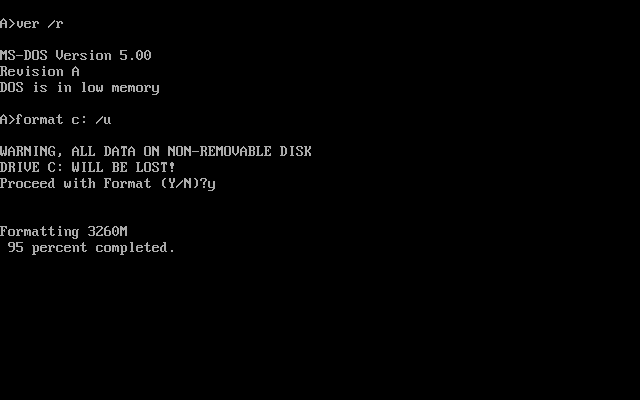For those of you who are adventurous and want to try out the device driver without setting up your own server, or who want to test the "across the Internet" feature, I have something for you ...
For a limited time I'm hosting some public disk images for people to play with. If you connect to brutman.com:2002 the following disk images are available:
(Note: all names are case sensitive as the server is running Linux.)
Hard drive images:
- fat12.dsk: 32MB, FAT12, suitable for all systems running DOS 2.0 or better. Utilities and RLE files.
- bigdisk.dsk: 200MB, FAT16 with DOS utilities, shareware games, etc.
- hugedisk.dsk: 2GB FAT16 disk, mostly empty.
bigdisk.dsk is probably the most interesting, as it has a collection of my favorite utilities, some reasonably good shareware games, RLE graphics, and other things to play with. fat12.dsk has the utilities and RLE graphics, but not much else due to the size. hugedisk.dsk is empty; it’s just there so that you can test mounting a 2GB disk image.
Floppy disk images:
- ibm_dos_11.dsk: IBM DOS 1.1 on the original 160KB diskette
- buick_1.dsk and buick_2.dsk: Demo disks from the late 1980s
- pcmag_march_1988.dsk: PC Magazine shareware/utility disk from March 1988
ibm_dos_11.dsk is mildly interesting because it is a 160K format without a BIOS Parameter Block, and that gives disk imagers like WinImage a hard time. (NetDrive has some special code to handle these.) The BASIC programs will run but the rest of the programs should not be run because they’ll crash a modern DOS system. The Buick demos will start but some of the code assumes you are using a floppy drive and asks you to switch diskettes, so you might not get far. The PC Magazine diskette is a small time capsule of utilities; it’s hard to believe that people distributed software that way now.
All of these images will appear writable to you, so you can play games and update high-score files, run benchmarks (including write speed testing), or just mess around. Your changes will only last for the duration of the session; when you disconnect the changes are lost. (The server has the “session scoped writes” feature described above turned on.) To keep the server from running out of space there is a maximum number of writes allowed per session, a maximum session length, and a timeout timer.
